0 votes 1 answer Prove that the curves x = y^2 and xy = k intersect at right angles if 8k^2 =1 asked in Mathematics by Nisa (598k points)Has degree 3 in x and degree 2 in y Degree function in abstract algebra Given a ring R, the polynomial ring Rx is the set of all polynomials in x that have coefficients in R In the special case that R is also a field, the polynomial ring Rx is a principal ideal domain and, more importantly to our discussion here, a Euclidean domain This is a semiimportant identity to know (x^3y^3)=(xy)(x^2xyy^2) Although it doesn't apply directly to this question, it's also important to know that (x^3y^3)=(xy)(x^2xyy^2) This gives us the rule (x^3y^3)=(xy)(x^2∓xyy^2)
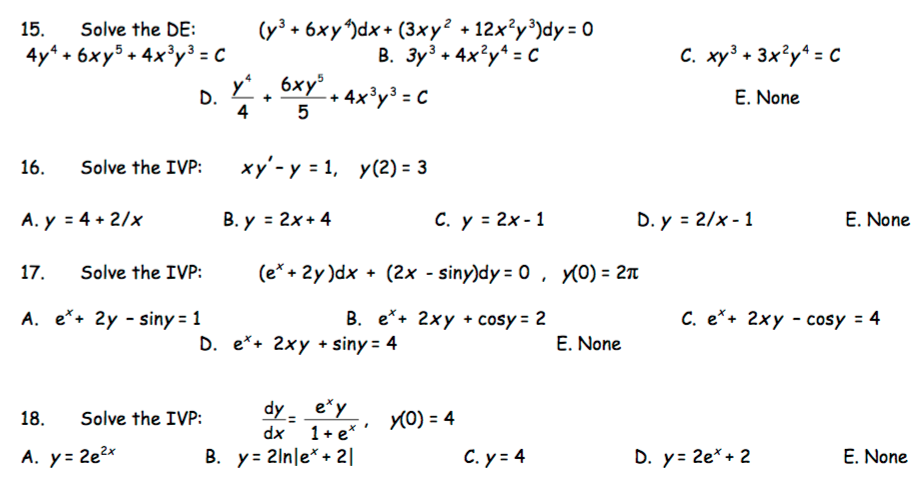
Solved Solve The De Y 3 6xy 4 Dx 3 Xy 2 12x 2y 3 Dy Chegg Com
X 3 y 3 x y x 2xy y 2
X 3 y 3 x y x 2xy y 2-X 2sin y x 22y ≤ sin2 y The limits of the outer two functions as (x,y) → (0,0) are both 0, and so the Squeeze Theorem tells us that lim (x,y)→(0,0) x2 sin2 y x2 2y2 = 0 The notion of the limit of a function of two variables readily extends to functions of three or more variablesUse the method of cylindrical shells to find the volume generated by rotating the region bounded by the given curves about the axis Sketch the region and a



上 Xy Y2 X X X Y Y X 3 Y 3 X Y X 2 Xy Y 2
N x = y ( x 2 x y 1 ) e xy ( 2 x y ) e xy = ( x y 2 x 2 y 2 x 2 y ) e xy = m y The new equation is exact As was mentioned in class, there may be more than one integrating factor Here μ = (xy)1 will also work, although we have given no way to find this integrating factor, other than after solving the differential equationAnswer by lenny460 (1073) ( Show Source ) You can put this solution on YOUR website!Plot x^2 y^3, x=11, y=03 WolframAlpha Volume of a cylinder?
SOLUTION 1 Begin with x 3 y 3 = 4 Differentiate both sides of the equation, getting D ( x 3 y 3) = D ( 4 ) , D ( x 3) D ( y 3) = D ( 4 ) , (Remember to use the chain rule on D ( y 3) ) 3x 2 3y 2 y' = 0 , so that (Now solve for y' ) 3y 2 y' = 3x 2, and Click HERE to return to the list of problems SOLUTION 2 Begin with (xy) 2 = x y 1 Differentiate both sides The problem to solve is xyx3y3 Multiply y and x Multiply the y and x Multiply y and x The y just gets copied along The x just gets copied along The answer is yx yx x*y evaluates to yx x*yx evaluates to yxx Multiply y and 3 Multiply y and 1 The y just gets copied alongX 2 −xy, dy dt = 3y 1− y 3 −2xy To find the xnullcline, we solve2x 1− x 2 − xy = 0, where multiplying out and collecting the common factor of x gives x(2− x− y) = 0 This gives two xnullclines, the linexy = 2 and the yaxis By plugging in the points (1,0) and (2,2) into2x 1− x 2 − xy, we see that solutions
For example the command 2x @ 3 evaluates the expression 2x for x=3, which is equal to 2*3 or 6 Algebra Calculator can also evaluate expressions that contain variables x and y To evaluate an expression containing x and y, enter the expression you want to evaluate, followed by the @ sign and an ordered pair containing your xvalue and yvalueSystemofequationscalculator 3x^2=y, x1=y en Related Symbolab blog posts High School Math Solutions – Systems of Equations Calculator, Elimination A system of equations is a collection of two or more equations with the same set of variables In this blog post,Solution for x'y' 3xy = 10xy y = Cx3/2 Q Give the domain and the range of the function whose graph is shown to the rightWhen arrows are dra A • Domain is the set of all values of x for which the function f(x) is defined and takes a finite val
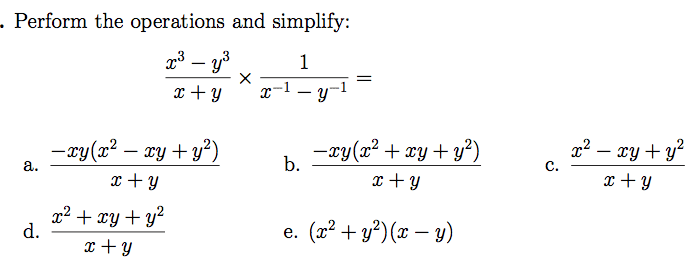



Oneclass Perform The Operations And Simplify X3 Y3 X Y Times 1 X 1 Y 1 Xy X2 Xy Y2 X
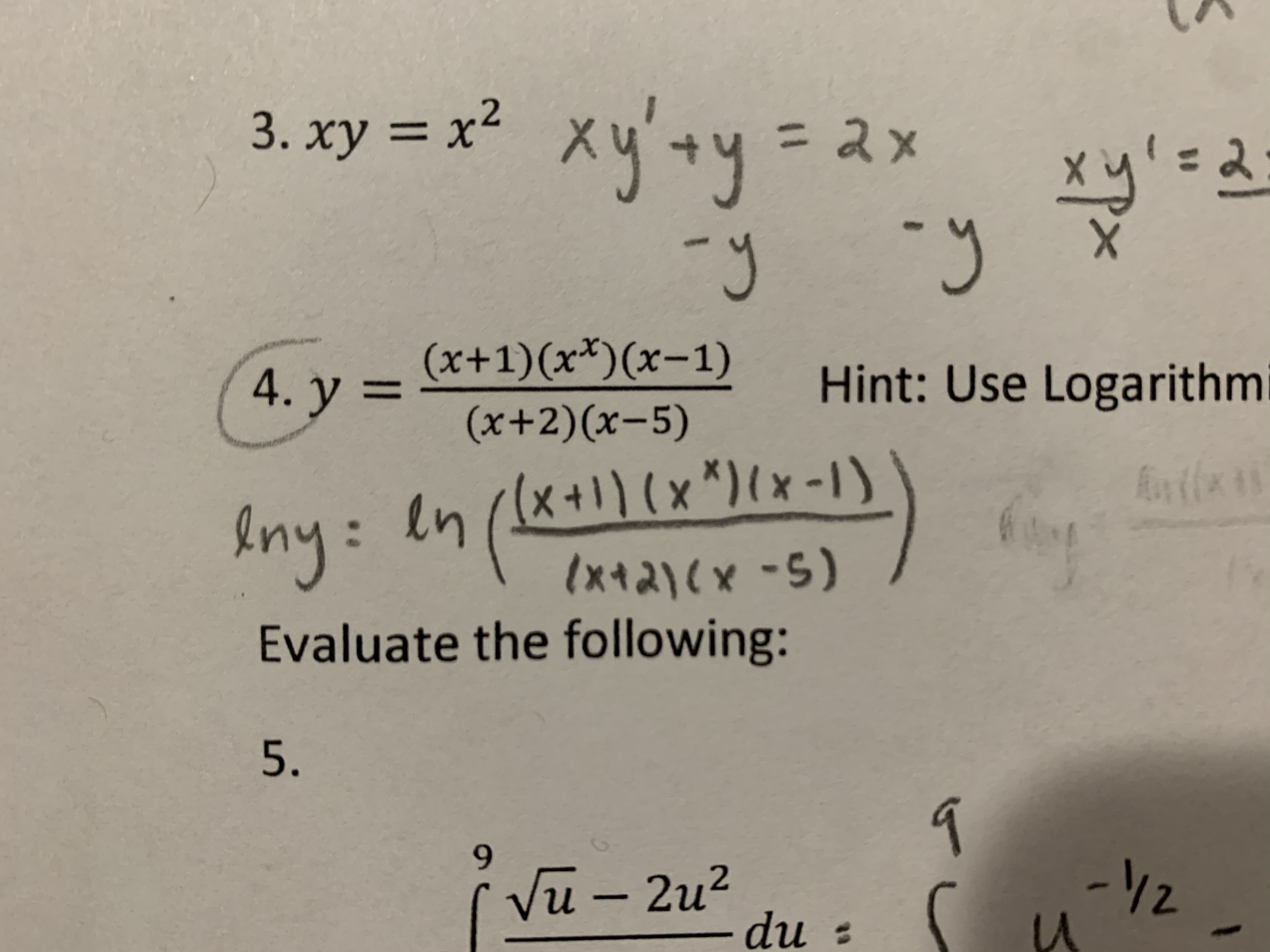



Answered 3 Xy X Xy Y Xy Y 3 Hu H Xy D Bartleby
We think you wrote 2xy^2y^22x^3x^2/2xy^32xy^2x^2y^2 This deals with reducing fractions to their lowest termsSolve $\left(xy^3y \right)dx2\left(x^2y^2xy^4\right)=0$ written 37 years ago by smitapn612 ♦ 90 modified 18 months ago by sanketshingote ♦ 640Extended Keyboard Examples Upload Random Compute answers using Wolfram's breakthrough technology & knowledgebase, relied on by millions of students & professionals For math, science, nutrition, history, geography, engineering, mathematics, linguistics, sports, finance, music




Ex 2 5 12 Verify That X3 Y3 Z3 3xyz 1 2 Ex 2 5




Verify The Following I X 3 Y 3 X Y X 2 Xy Y 2 Ii X 3 Y 3 X Y X 2 Xy Y 2
Find the condition that the curves 2x = y^2 and 2xy = k intersect orthogonally asked in Mathematics by AsutoshSahni (527k points) application of derivative;(xyz)^3 (x y z) (x y z) (x y z) We multiply using the FOIL Method x * x = x^2 x * y = xy x * z = xz y * x = xySimple and best practice solution for 3x2yxy(x3y)y^2= equation Check how easy it is, and learn it for the future Our solution is simple, and easy to understand, so don`t hesitate to use it as a solution of your homework
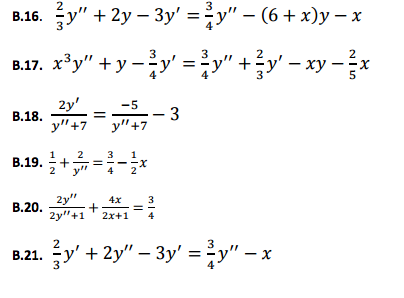



Solved 2 3 Y 2y 3y 3 4 Y 6 X Y X X 3 Y Y Chegg Com




Solve Y 2 2x 2y Dx 2x 3 Xy Dy 0 Mathematics Stack Exchange
First type the equation 2x3=15 Then type the @ symbol Then type x=6 Try it now 2x3=15 @ x=6 Clickable Demo Try entering 2x3=15 @ x=6 into the text box After you enter the expression, Algebra Calculator will plug x=6 in for the equation 2x3=15 2(6)3 = 15 The calculator prints "True" to let you know that the answer is right More ExamplesIf I couldn't do the above one, which looks a heck of a lot simpler, I doubt I'll get through this one x^ (6/7) y^ (8/5) = 16Uploaded By MateIron5245 Pages 27 This preview shows page 24 27 out of 27 pages View full document See Page 1 solution Here, M ( x, y ) = 3 xy y 2 , and N ( x, y ) = x 2 xy, 24 so that @ M ( x, y ) @ y = 3 x 2 y, and @ N ( x, y ) @ x = 2 x y Therefore, M y



How To Derive X 3 Y 3 X Y X 2 Xy Y 2 Quora




An Introduction To Elliptic Curves Atm Conference Telford
F(x,y)dydx = Z 1 0 Z 2 0 (cx2 xy 3)dydx = 2c 3 1 3, so c = 1 (b) Draw a picture of the support set (a 1by2 rectangle), and intersect it with the set {(x,y) x y ≥ 1}, which is the region above the line y = 1 − x See figure above, right To compute the probability, we double integrate the joint density over this subset of theXy − 3 x 2 ) dx ( x 2 2 y ) dy = 0 SOLUTION (a) M = 2 xy − 3 x 2 ; Well, working backwards from (xy)(xy) you get x(xy)y(xy)=x 2xyxyy 2 For the difference of two cubes, x 3y 3 =(xy)(x 2 xyy 2) so again working backwards you get x(x 2 xyy 2)y(x 2 xyy 2) expanding, x 3 x 2 yxy 2x 2 yxy 2y 3




If X Y 3 X Y 2 Then What Is The Value Of X 3 Y 3 A 6 B 7 C 8 D 9 E None Of These




Solved Solve The De Y 3 6xy 4 Dx 3 Xy 2 12x 2y 3 Dy Chegg Com
(x y) 3 = x 3 3x 2 y 3xy 2 y 3 Example (1 a 2 ) 3 = 1 3 31 2 a 2 31(a 2 ) 2 (a 2 ) 3 = 1 3a 2 3a 4 a 6 (x y z) 2 = x 2 y 2 z 2 2xy 2xz 2yzCho tam giác MNP vuông tại M,đường cao MH a, Chứng minh tam giác HMN đồng dạng với tam giác MNP b, chứng minh hệ thức M H 2 =NHPH c, Lấy điểm E tùy ý trên cạnh MP,vẽ điểm F trên cạnh MN sao cho góc FHE =90 độAnswer (1 of 3) x^3 x^2 x y x y 1 = x^2(x 1) x 1 (x y y) = x^2(x 1) x 1 y(1 x) = x^2(x 1) x 1 y(x 1) = (x 1)(x^2 1 y)
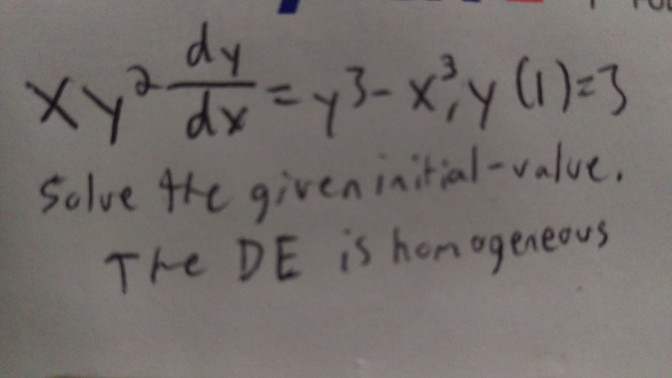



Solved Xy 2 Dy Dx Y 3 X 3 Y 1 3 Solve The Given Chegg Com
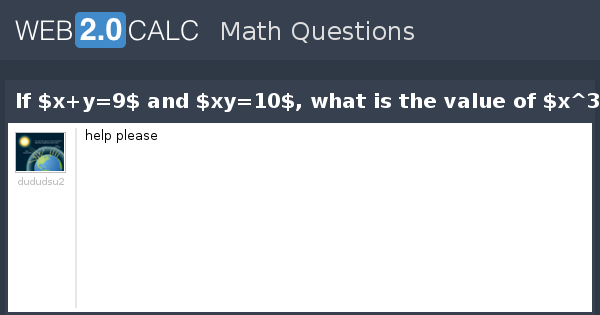



View Question If X Y 9 And Xy 10 What Is The Value Of X 3 Y 3
Xy'y=x^{2}2x1 en Related Symbolab blog posts Advanced Math Solutions – Ordinary Differential Equations Calculator, Exact Differential Equations In the previous posts, we have covered three types of ordinary differential equations, (ODE) We have now reachedX 3 y 3 = ( x y) ( x 2 − x y y 2) Use the distributive property to multiply xy by x^ {2}xyy^ {2} and combine like terms Use the distributive property to multiply x y by x 2 − x y y 2 and combine like terms x^ {3}y^ {3}=x^ {3}y^ {3} x 3 y3 < x < s 28 3 5 Problem 15 (xy2 bx2y)dx(xy)x2 dy = 0 First, for this to be exact M y = 2xy bx2 = 3x2 2xy = N x So b = 3 With this, find the solution to the DE f(x,y) = Z M dx = Z xy 23x2ydx = 1 2 x y2 x3y g(y) And solve for g(y) f y = x 2y x3 g0(y) = x3 x y So we didn't need g(y) This leaves 1 2 x 2y x3y = C 6 Problem
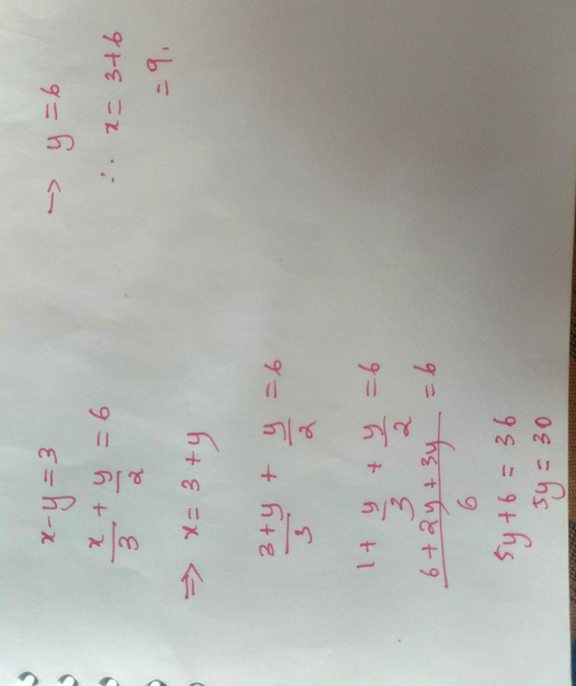



Solve X Y 3 And X 3 Y 2 6 By Substituting Methos Scholr
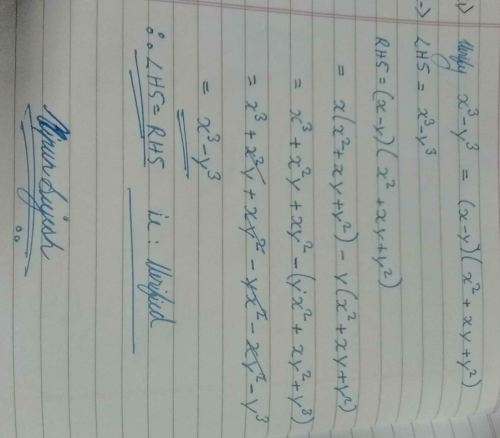



Verify X 3 Y 3 X Y X 2 Y 2 Xy Edurev Class 9 Question
2x35x2yxy26y3 Final result 2x3 5x2y xy2 6y3 Step by step solution Step 1 Equation at the end of step 1 (((2•(x3))((5•(x2))•y))(x•(y2)))(2A first order Differential Equation is Homogeneous when it can be in this form dy dx = F ( y x ) We can solve it using Separation of Variables but first we create a new variable v = y x v = y x which is also y = vx And dy dx = d (vx) dx = v dx dx x dv dx (by the Product Rule) Which can be simplified to dy dx = v x dv dx∂ N ∂ x = 2 x Since the two partials are equal, the equation is exact (b) The solution is F (x, y) = C, where 1 F = ∫ M ∂ x f ( y ) F = ( 2 xy − 3 x 2 ) ∂ x f ( y ) F =




Find X Y X Y If X 2 3 Y 3 2 Ii X 2 5 Y 1 2 X 5 4 Y 1 3
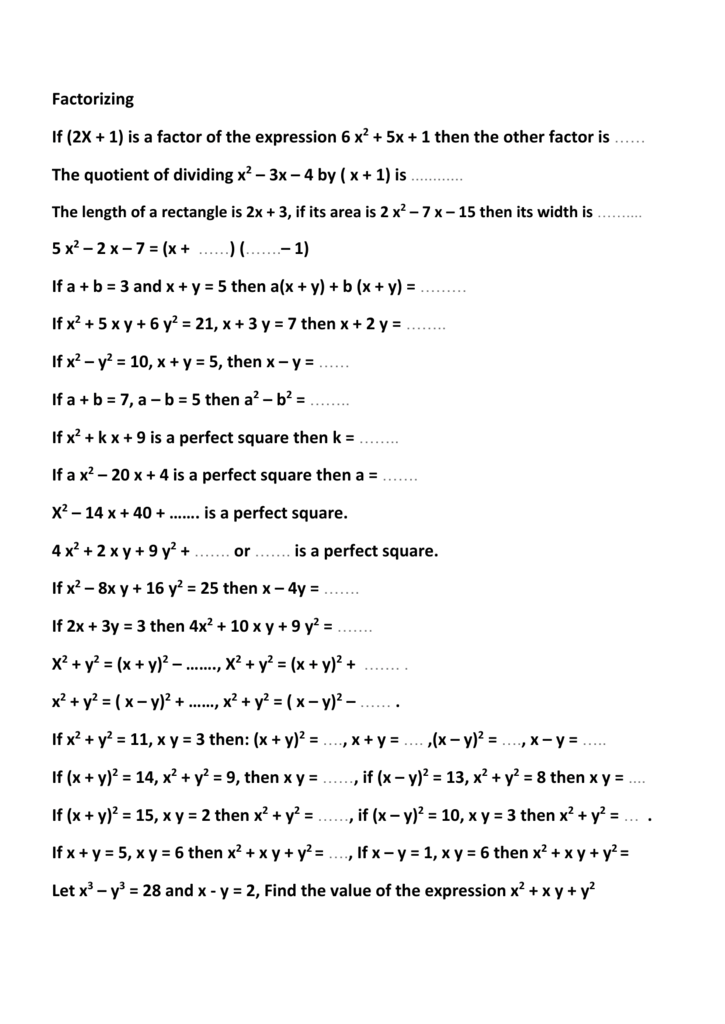



Factorizing If 2x 1 Is A Factor Of The Expression 6 X2 5x
Section 21 Limits In this section we will take a look at limits involving functions of more than one variable In fact, we will concentrate mostly on limits of functions of two variables, but the ideas can be extended out to functions with more than two variables∂M ∂ y = 2 x N = x 2 2 y;Answer (1 of 8) Given 2^x=3^y=6^z Lets assume that each and every term is equal to k Which implies 2^x=k Now by applying logarithm on both sides we get x=log k to base 2 and 1/x= log 2 to base k And 3^y=k Again by applying logarithm on both sides we get y=log k
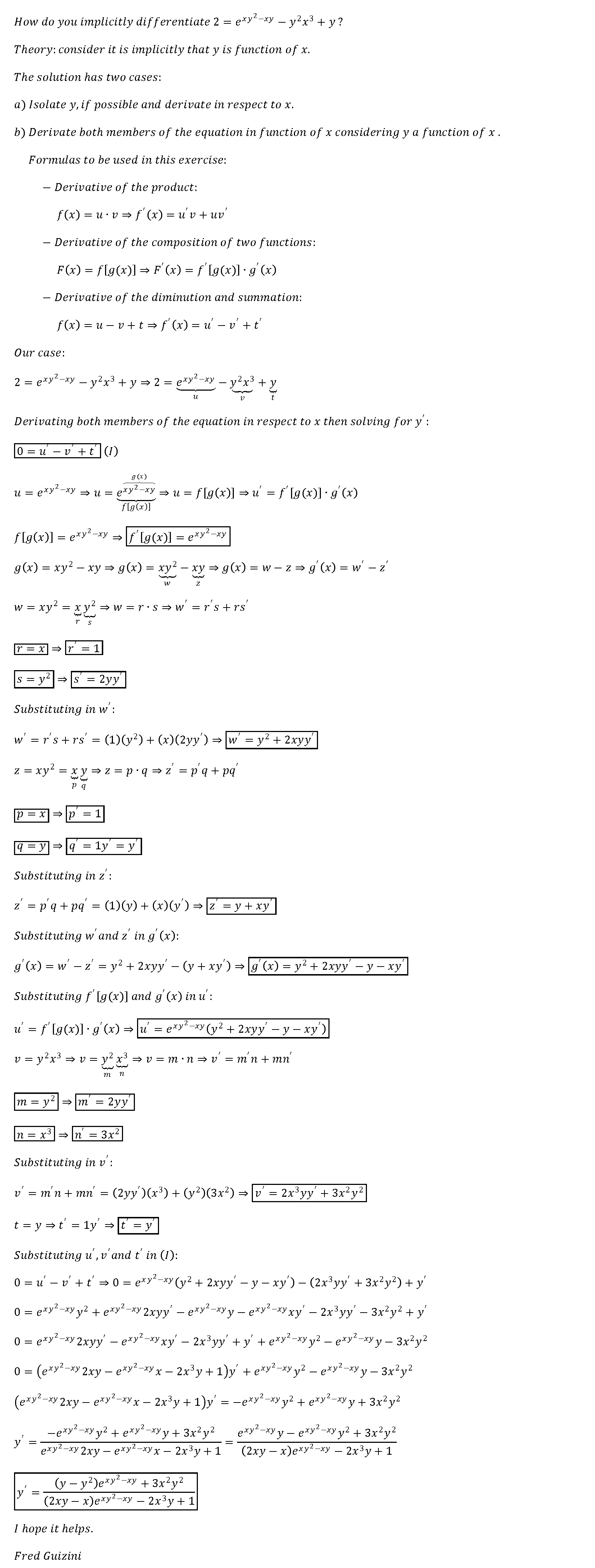



How Do You Implicitly Differentiate 2 E Xy 2 Xy Y 2x 3 Y Socratic




X 3 Y 3 Z 3 3xyz X Y Z X 2 Y 2 Z 2 Xy Yz Zx A 3 B 3 C 3 3abc A B C A 2 B 2 C 2 Ab Ca Youtube
The simplified expressions are i) x 3 5x 2 5x ii) a 2 b 3 3a 2 5b 3 iii) t 3 st s 2 t 2 s 3 iv) 4ac v) 3x 2 y 2 4xy vi) x 3 y 3 vii) 225x 2 16y 2 viii) a 2 b 2 c 2 2ab ☛ Check NCERT Solutions for Class 8 Maths Chapter 9Simple and best practice solution for x/y=2/3 equation Check how easy it is, and learn it for the future Our solution is simple, and easy to understand, Stack Exchange network consists of 178 Q&A communities including Stack Overflow, the largest, most trusted online community for developers to learn, share their knowledge, and build their careers Visit Stack Exchange




Factoring And The Factor Theorem Hints To Determine Each Type Ppt Download




Verify I X3 Y3 X Y X2 Xy Y2 Brainly In
2 $\begingroup$ I can prove that $x^3y^3 = (xy)(x^2xyy^2)$ by expanding the right side $x^3y^3 = (xy)x^2 (xy)(xy) (xy)y^2$ $\implies x^3 x^2y x^2y xy^2 xy^2 y^3$ $\implies x^3 y^3$ I was wondering what are other ways to prove that $x^3y^3 = (xy)(x^2xyy^2)$3x(x 2 2x – 5) Content Continues Below Factor 26 x sqrt9 y 3 – 13 y sqrt4 x 2 y xy sqrt169 x 4 y 3 , assuming that all variables are nonnegativePiece of cake Unlock StepbyStep Natural Language




Solved Dy 11 If X Xy 3y 3 Then At The Point 2 1 Chegg Com



Cho Hệ Phương Trinh X 3 Y 3 X 2y Xy 2 2xy X Y 0 Vietjack Com
Simplify (xy^2)^3 (xy2)3 ( x y 2) 3 Apply the product rule to xy2 x y 2 x3(y2)3 x 3 ( y 2) 3 Multiply the exponents in (y2)3 ( y 2) 3 Tap for more steps Apply the power rule and multiply exponents, ( a m) n = a m n ( a m) n = a m n x 3 y 2 ⋅ 3 x 3 y 2 ⋅ 3 Multiply 2 2 by 3 3Factor x^3xy^2x^2yy^3 x3 − xy2 x2y − y3 x 3 x y 2 x 2 y y 3 Factor out the greatest common factor from each group Tap for more steps Group the first two terms and the last two terms ( x 3 − x y 2) x 2 y − y 3 ( x 3 x y 2) x 2 y y 3 Factor out the greatest common factor ( GCF) from each group Transcript Ex 53, 6 Find 𝑑𝑦/𝑑𝑥 in, 𝑥3 𝑥2𝑦 𝑥𝑦2 𝑦3 = 81 𝑥3 𝑥2𝑦 𝑥𝑦2 𝑦3 = 81 Differentiating both sides 𝑤𝑟𝑡𝑥
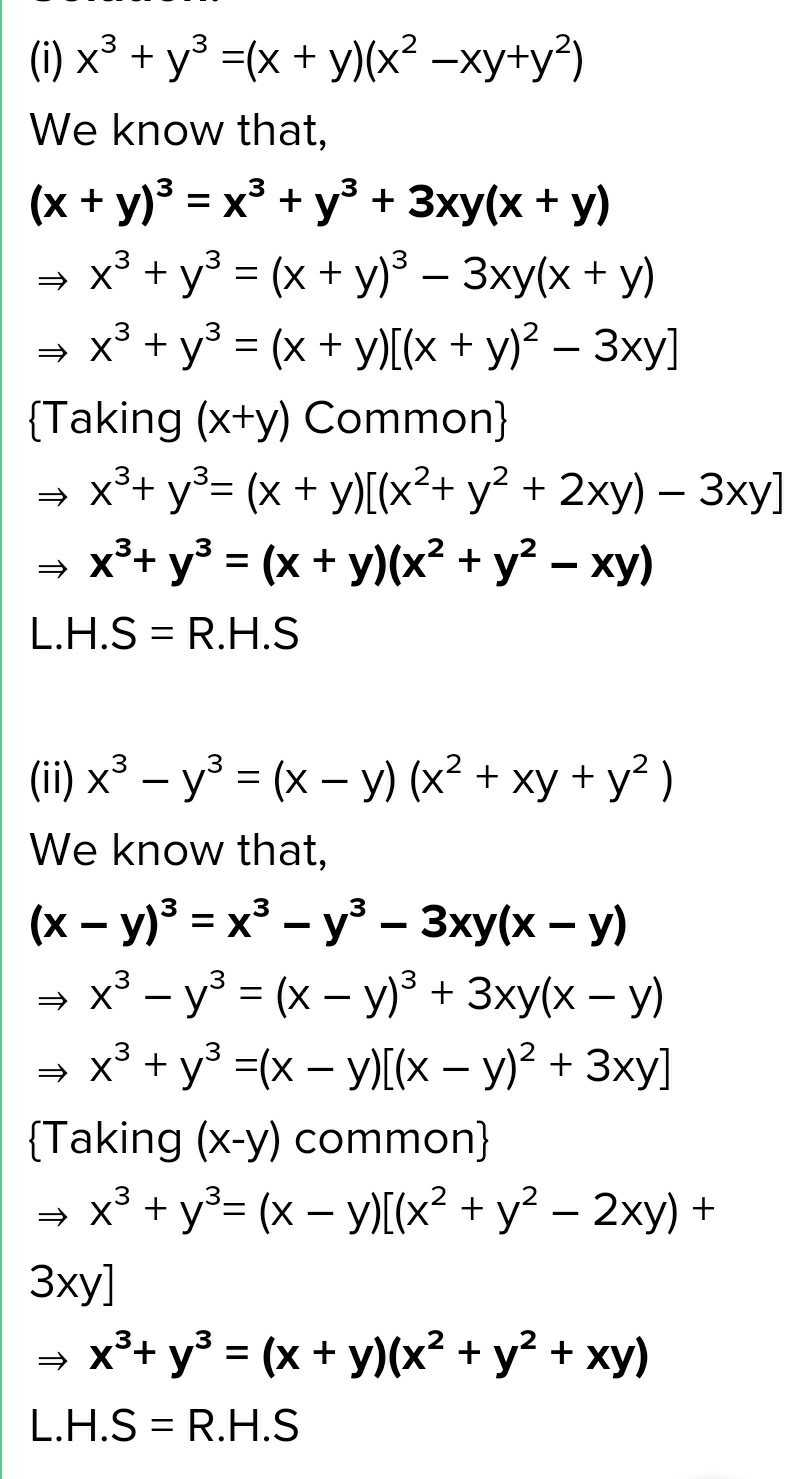



9 Verify I X3 Y3 X Y X2 Xy Y Ii P X Y X2 Xy Scholr




Expert Answer What Are The Factors Of X Y 3 X3 Y3 Brainly In
This gives us the equations n = xy = yx x != y (Note that for this example, the != stands for not equal to similar to some programming languages) xy always equals yx due to the communtative property of multiplication So there are actually an infinite number of answers Some are given below 6 = (2)(3) = (3)(2), 2 != 3 12 = (3)(4) = (4)(3), 3(x y)(x^2 xy y^2) xy(x y) They both have an x y in common (x y)(x^2 xy y^2) (xy) Now simplify (x y ( x^2 2xy y^2) 2) This is a difference of squares 81x^4 16y^4 = (9x^2)^2 (4y^2)^2 = (9x^2 4y^2)(9x^2 4y^2) But the first is a difference of squares, so that can be factored again (3x 2y)(3x 2ySolve 2xy/ X Y = 3/2 Xy/ 2x Y = 3/10 X Y ≠ 0 and 2x Y ≠ 0 CISCE ICSE Class 9 Question Papers 10 Textbook Solutions Important Solutions 6 Question Bank Solutions 145 Concept Notes & Videos 431 Syllabus Advertisement Remove all ads Solve 2xy/ X Y = 3/2 Xy/ 2x Y = 3/10 X Y ≠ 0 and 2x Y ≠ 0
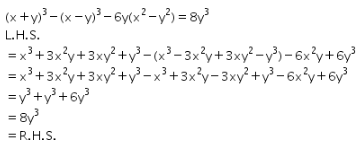



Prove That X Y 3 X Y 3 6y X2 Y2 8y3 Cbse Class 9 Maths Learn Cbse Forum




If X Y Z 0 Show That X 3 Y 3 Z 3 3xyz With Video
SOLUTION 15 Since the equation x 2 xy y 2 = 3 represents an ellipse, the largest and smallest values of y will occur at the highest and lowest points of the ellipse This is where tangent lines to the graph are horizontal, ie, where the first derivative y'=0311 Linearization and Differentials Ex2324數學系卡安很閒 所以決定拯救沒辦法用slader和chegg的莘莘學子Derivatives in Differential FormIn Exercises 19–38, find dy23 2y^(3 Find dy/dx by implicit differentiation 1 x^3 xy y^2= 7 The given answer is (y3x^2)/ (2yx), but I'm not getting it 2 How would I do this one?
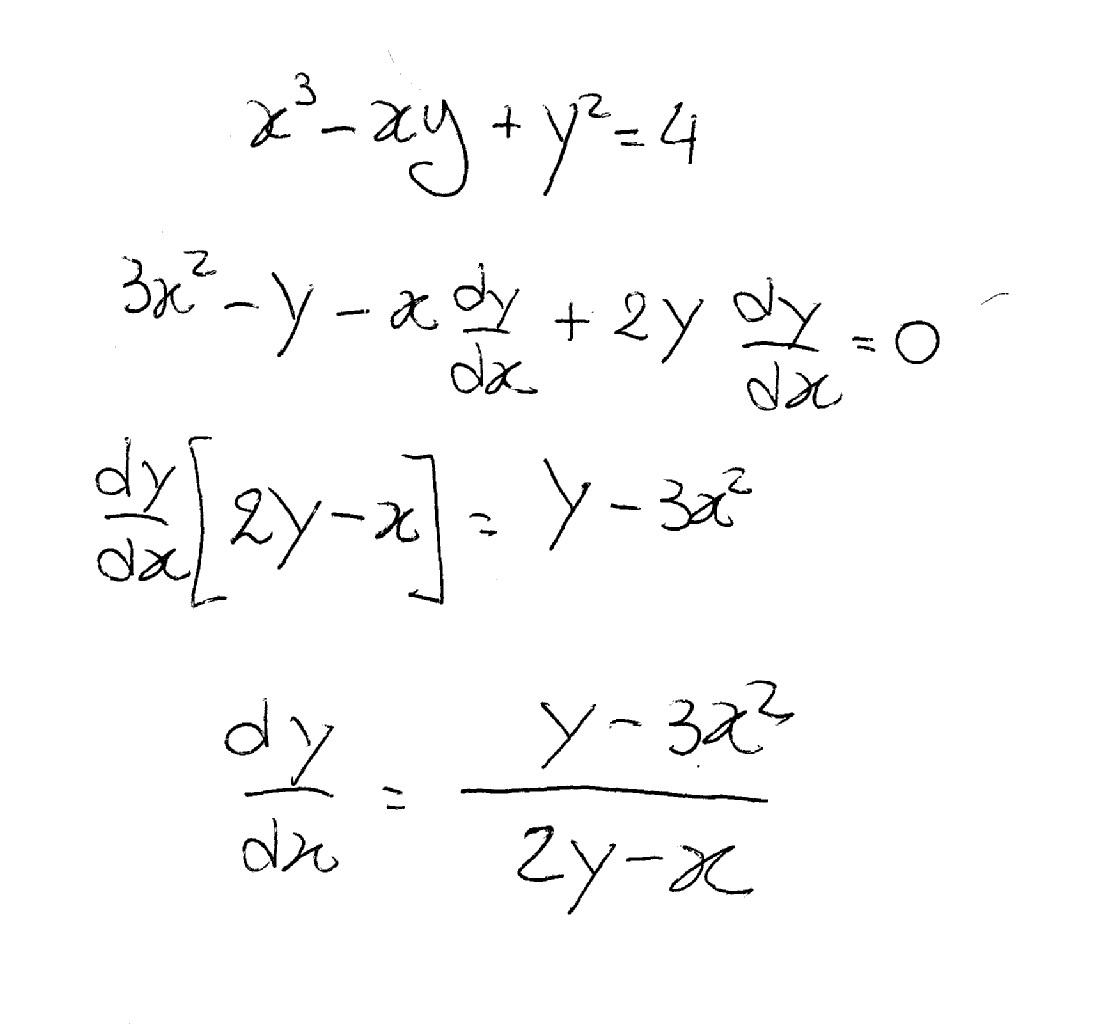



How Do You Differentiate X 3 Xy Y 2 4 Socratic




Class 9 Polynomial 2 Coordinate Geometry Linear Equation In Two Variables Euclid S Geometry Lines And Angles Notes
Ex 25, 9Verify (i) x3 y3 = (x y) (x2 – xy y2)LHS x3 y3We know (x y)3 = x3 y3 3xy (x y)So, x3 y3 = (x y)3 – 3xy (x y) = (x y)3 – 3xy




Verify X3 Y3 And X3 Y3 Std 9 Maths Ex 2 5 Q 9 Youtube
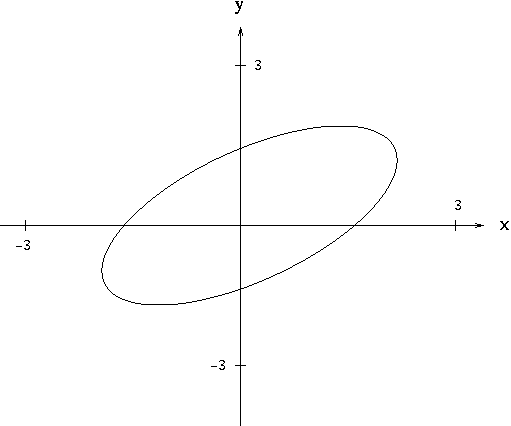



Implicit Differentiation




New Question Verify That X3 Y3 Z3 3xyx 1 2 X Y Z X Y 2 Y Z 2 Z X 2 Tex Textless H2 Brainly In




X 2 Y 2 60 And X Y 6 Then Find The Value Of X 3 Y 3 Mathematics Topperlearning Com Ssrtn7qq




Dy Dx Xy 2y X 2 Xy 3y X 3 Variables Separables Alexander Estrada Youtube




How To Show That Limit Of X 3 Y 3 X Y Does Not Exist At Origin Mathematics Stack Exchange




Ex 5 3 5 Find Dy Dx In X2 Xy Y2 100 Class 12




Schaum S Outline College Algebra Pdf Txt




The Factors Of X 3 X 2y X Y 2 Y 3 Are A X Y X 2 X Y Y 2 B X Y X 2 X Y Y 2 C Youtube



上 Xy Y2 X X X Y Y X 3 Y 3 X Y X 2 Xy Y 2




How Can We Verify Q Ii X3 Y3 X Y X2 Xy Y2 Maths Polynomials Meritnation Com




Class 9 Polynomial 2 Coordinate Geometry Linear Equation In Two Variables Euclid S Geometry Lines And Angles Notes




Reshit Sistemu Uravnenij X 2 Y 2 3 X 3 Y 3 7 X Y Shkolnye Znaniya Com
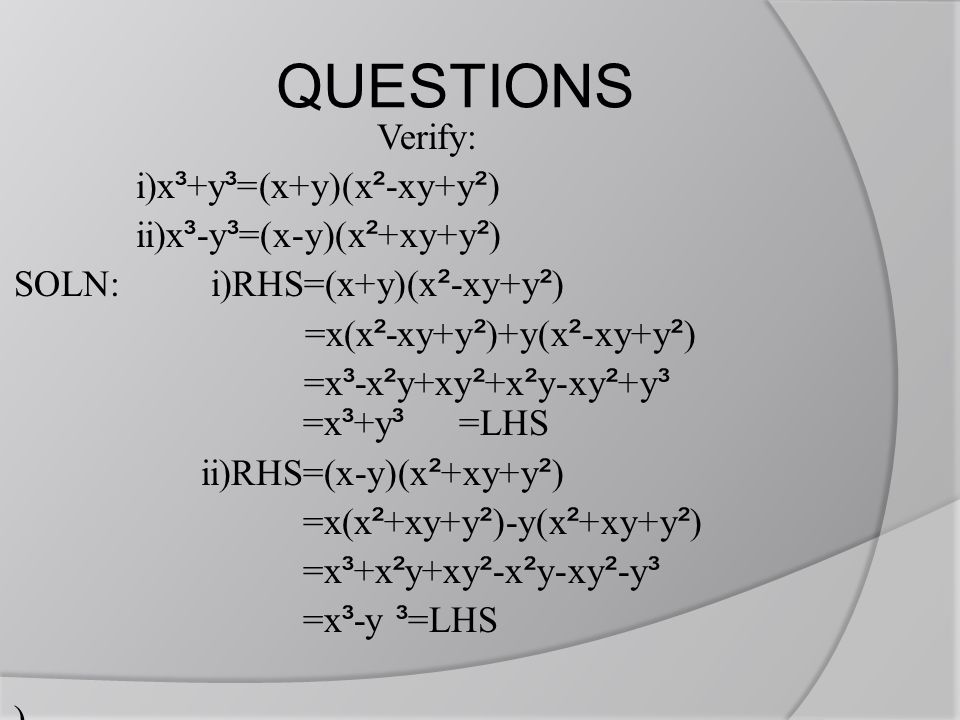



Polynomials Ppt Video Online Download



The Factors Of X 3 X 2 Y Xy 2 Y 3 Are A X Y X 2 Xy Y 2 Sarthaks Econnect Largest Online Education Community



X2 Y2 Formula




Calameo Deber 1




Solve Xy 3 Y Dx 2 X 2y 2 X Y 4 Dy 0 Youtube



If Math X Y 2 Math And Math X 3 Y 3 Math What Is Math X 2 Y 2 Math Quora




If F X Y 9 X 2 Y 2 If X 2 Y 2 Leq9 And F X Y 0 If X 2 Y 2 9 Study What Happens At 3 0 Mathematics Stack Exchange




A For X 2 And Y 3 Verify The Followingx3 Y3 X Y X Xy Y2 Please Give It Fast Brainly In




Algorithm For X 2 Xy Y 2 Z 2 With The Solution 1 1 1 That Download Scientific Diagram
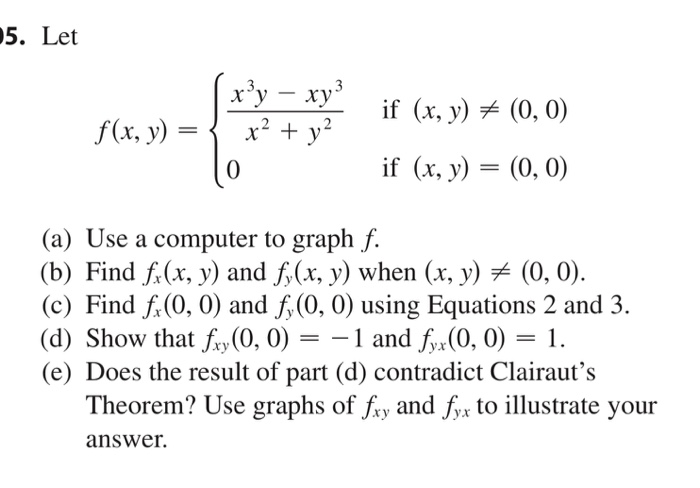



Solved Let F X Y X 3y Xy 3 X 2 Y 2 If X Y Chegg Com




Evaluate 98 3 Maths Questions



1




Verify X3 Y3 X Y X2 Y2 Xy Brainly In



If X 2 Xy Y 2 A 2 Show That D 2y Dx 3 6a 2 X 2y 3 Sarthaks Econnect Largest Online Education Community




Q62 If X3 Y3 X2 Xy Y2 5 1 And X2 Y2 X Y 7 1 Then The Ratio 2x 3y Equals Youtube



1




Y Xy 3 1 X 2 1 2 Y 0 1 Harushley
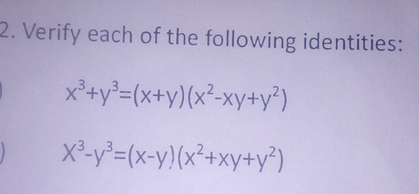



2 Verify Each Of The Following Identities X3 Y3 X Y X2 X Scholr




Verify I X3 Y3 X Y X2 Xy Y2 Ii X3 Y3 X Y X2 Xy Y2 Brainly In




Verify X3 Y3 X Y X2 Xy Y2 Verify X3 Y3 X Y X2 Xy Y2 Class 9th Exercise 2 5 Question 9 Youtube




F X Y X 2 Y Y Y F F X X 2xyx 2 3y Y Ln2 Z F X Y Cos Xy X Cos 2




If X 3 2 3 2 And Y 3 2 3 2 Then Find The Value Of X2 Xy Y2 Maths Number Systems Meritnation Com




Verify X3 Y3 X Y X2 Xy Y2 Brainly In
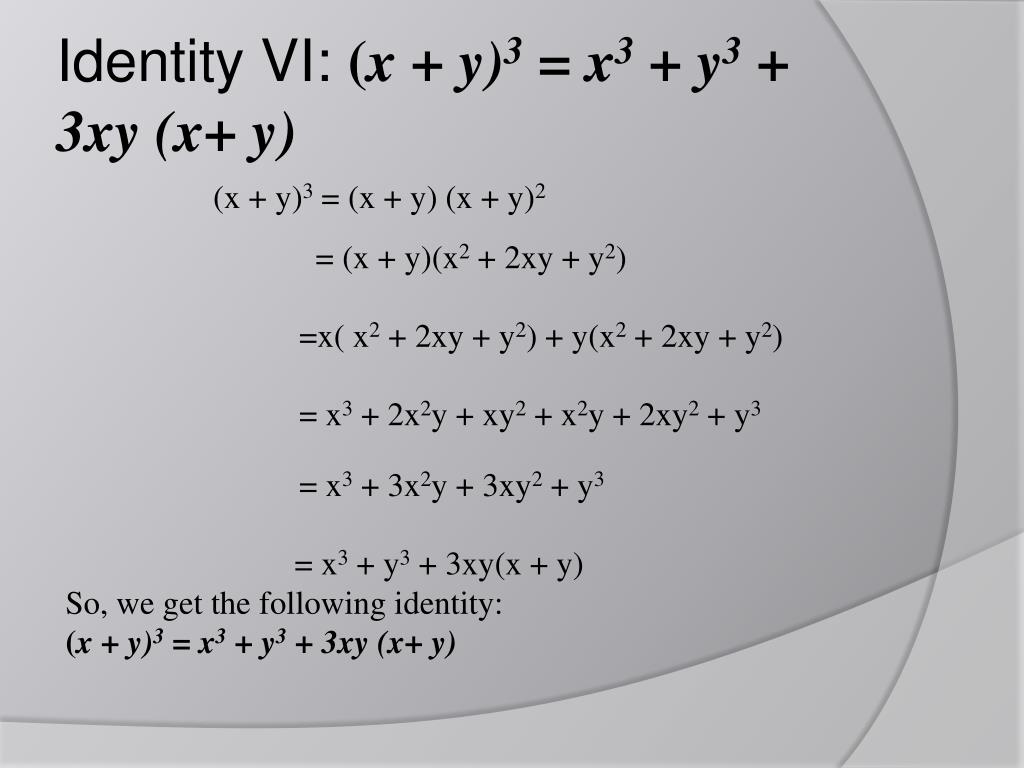



Ppt Polynomials Powerpoint Presentation Free Download Id




Verify X3 Y3 X Y X2 Xy Y2 Brainly In




Solved F X Y X 3y Xy 3 X 2 Y 2 X Y Notequalto Chegg Com




Sum The Series X Y X2 Xy Y2 X3 X2y Xy2 Y3 Maths Sequences And Series Meritnation Com



X Y 2




Mathematics Class 9th Chapter 4 Solution



If X Y 12 And Xy 27 Then Find The Value Of X3 Y3 Polynomials Maths Class 9




If X Y 7 And X3 Y3 133 Find I Xyii X Y Brainly In



X 3 Off 72 Medpharmres Com




If X 2 Y 2 49 And X Y 3 Then Find The Value Of X 3 Y 3




Verify X3 Y3 X Y X2 Y2 Xy Hence Factorise 216x3 125y3 Maths Polynomials Meritnation Com
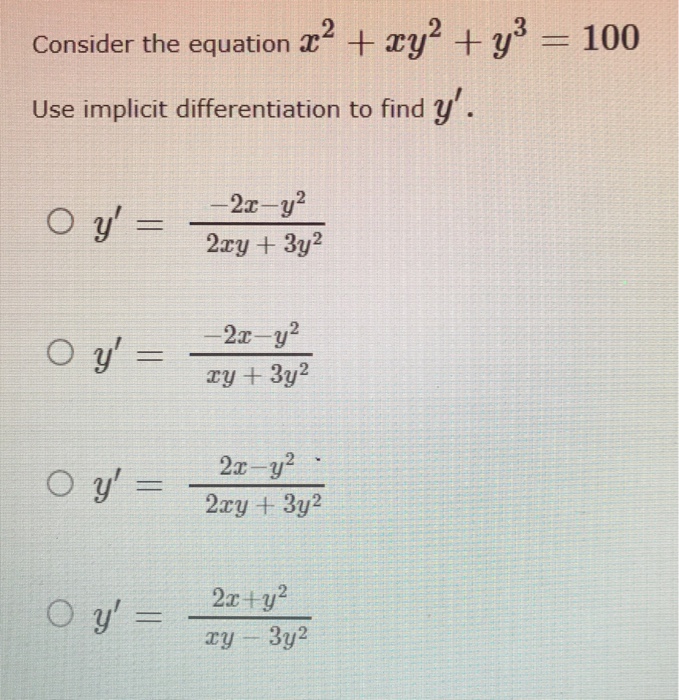



Solved Consider The Equation X 2 Xy 2 Y 3 100 Use Chegg Com



If X Y 2 Then What Is The Value Of X Y 6xy Quora
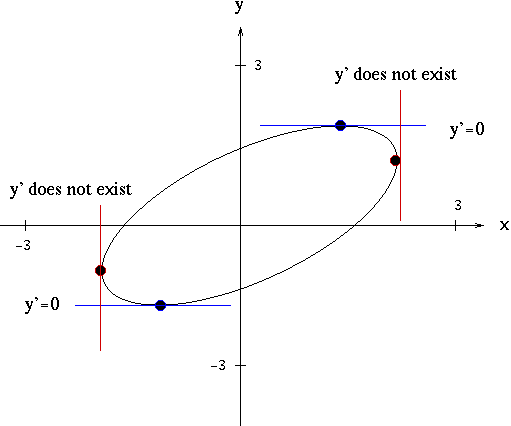



Solutions To Implicit Differentiation Problems



If X Y 3 Xy 28 Then What Will Be The Value Of X 2 Y 2 Quora




The Factors Of X 3 X 2y X Y 2 Y 3 Are A X Y X 2 X Y Y 2 B X Y X 2 X Y Y 2 C X Y 2 X Y D X Y 2 X Y



Show That X 4 Y 3 X2 16 Xy 12 Y2 9 X3 64 Y2 27 Hence Find The Value If X 3 Y 1 Mathematics Topperlearning Com 8446




Discuss The Maxima And Minima Of The Function U X 3y 2 1 X Y Answer Mathematics 1 Question Answer Collection



Find Dy Dx X 3 X 2 Y Xy 2 Y 3 81 Sarthaks Econnect Largest Online Education Community




Verify I X 3 Y 3 X Y X 2 X Y Y 2 Ii X 3 Y 3 X Y X 2 X Y Y 2




If X Y 3 And Xy 2 Then The Value Of X 3 Y 3 Is Equal To Brainly In




If X 3 2 3 2 Y 3 2 3 2 Find The Value Of X 2 Y 2 Xy Mathematics Topperlearning Com 9dqpqijj




F X Y X 2 Y 2 F 0 T T 2 0 T 2 F T 0 Kaikilla T 0 Pdf Free Download




Solved Let F X Y X 3 Xy 2 X 2 Y 2 If X 2 Y 2 Chegg Com




Verify I X 3 Y 3 X Y X 2 Xy Y 2 Ii X 3 Y 3 X Y X 2 Xy Y 2




Discuss The Maxima And Minima Of The Function U X 3y 2 1 X Y Answer Mathematics 1 Question Answer Collection




Ex 9 4 3 Vi Simplify X Y X 2 Xy Y




Y Xy 3 1 X 2 1 2 Y 0 1 Harushley




Solve 2xy X Y 3 2 Xy 2x Y 3 10 Mathematics Topperlearning Com X2oivz99



Verify X 3 Y 3 X Y X 2 Xy Y 2 Sarthaks Econnect Largest Online Education Community
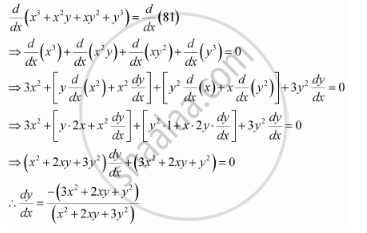



Find Dy Dx For X3 X2y Xy2 Y3 81 Mathematics Shaalaa Com
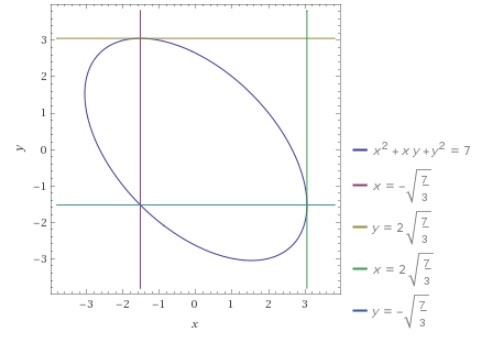



How Do You Find All Points On The Curve X 2 Xy Y 2 7 Where The Tangent Line Is Parallel To The X Axis And The Point Where The Tangent Line
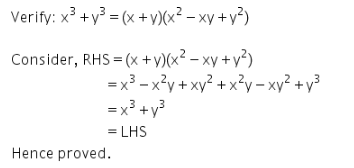



X3 Y3 X Y X2 Xy Y2 Cbse Class 9 Maths Learn Cbse Forum




Polynomials Class 9th Maths Ex 2 5 Q9 Verify I X3 Y3 X Y X2 Xy Y2 Youtube
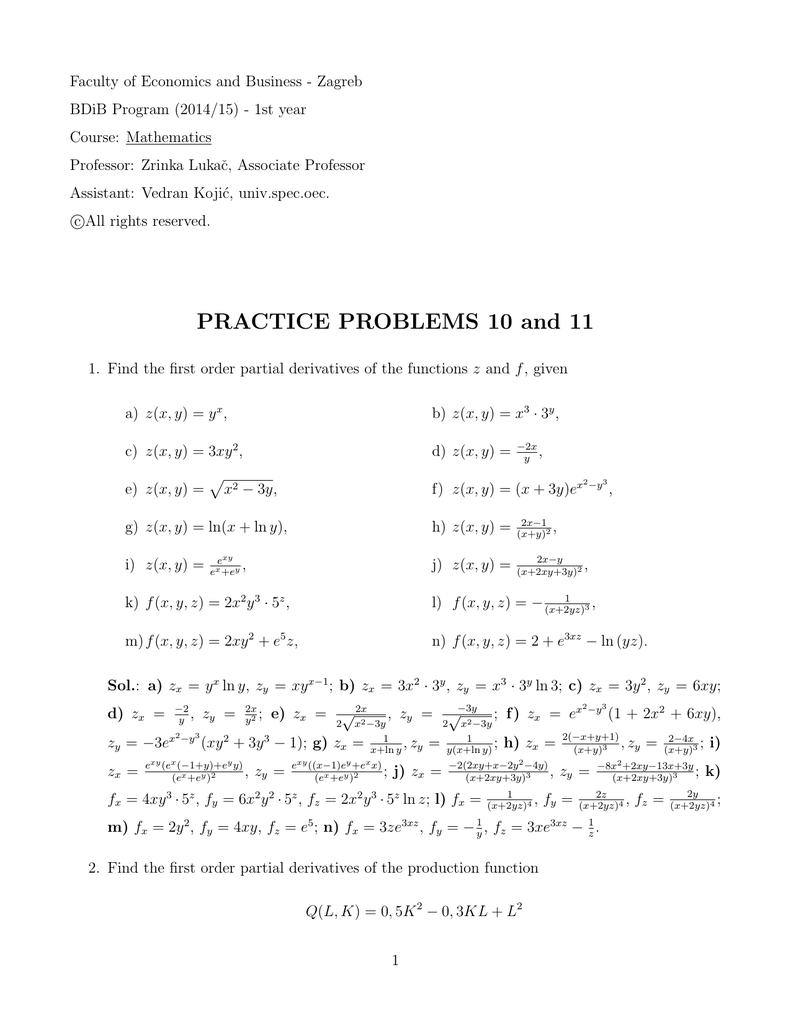



Practice Problems 10 And 11
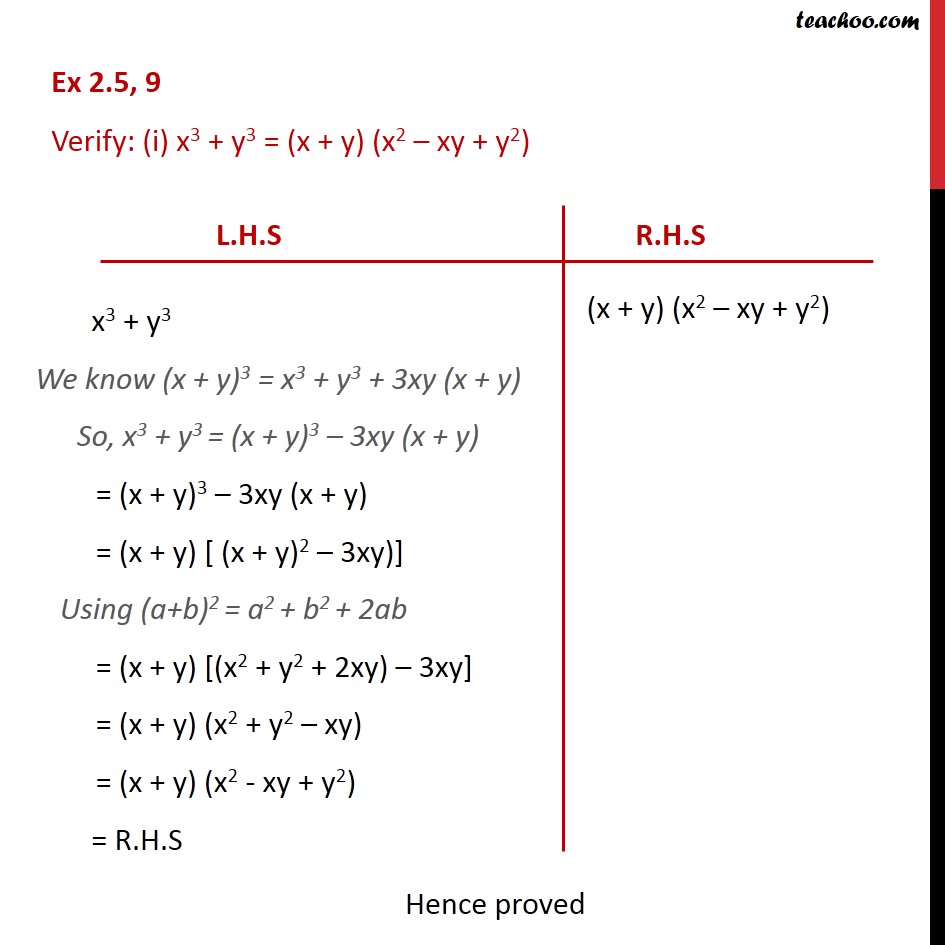



Ex 2 5 9 Verify I X 3 Y 3 X Y X 2 Xy Y 2 Teachoo




Please Help With Solution Verify X3 A Y3 X A Y X2 Xy Y2 And Hence Factorise Maths Number Systems Meritnation Com
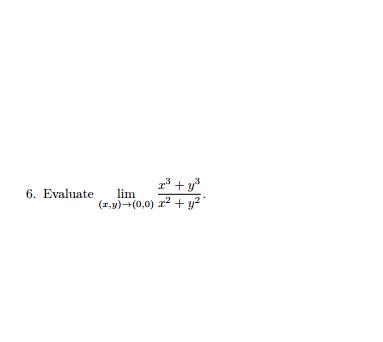



Solved Evaluate Lim X Y Rightarrow 0 0 X3 Y3 X2 Y2 Chegg Com




Chto Poluchitsya 3x Y X2 Xy X 3y Y2 Xy Shkolnye Znaniya Com




If X 2 Y 3 X 3y 2 Then Dy Dx Youtube



0 件のコメント:
コメントを投稿